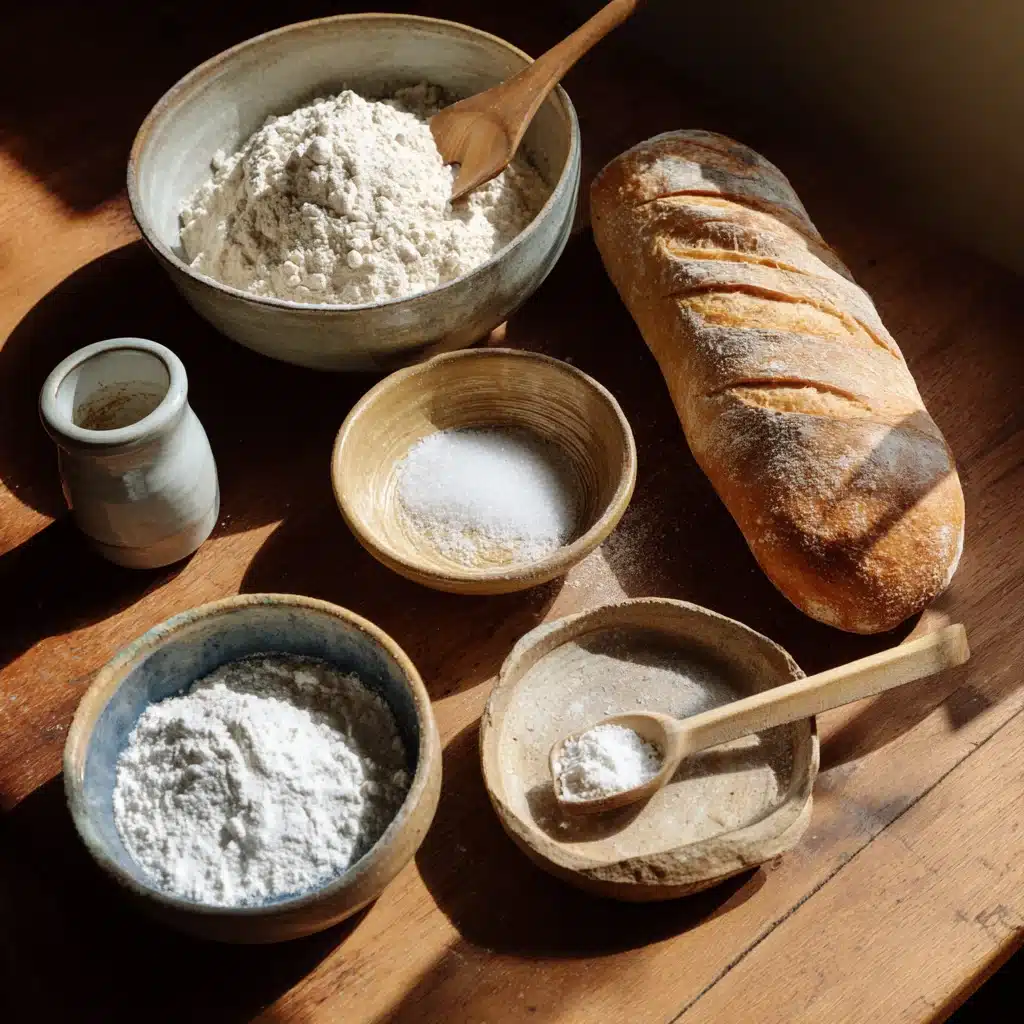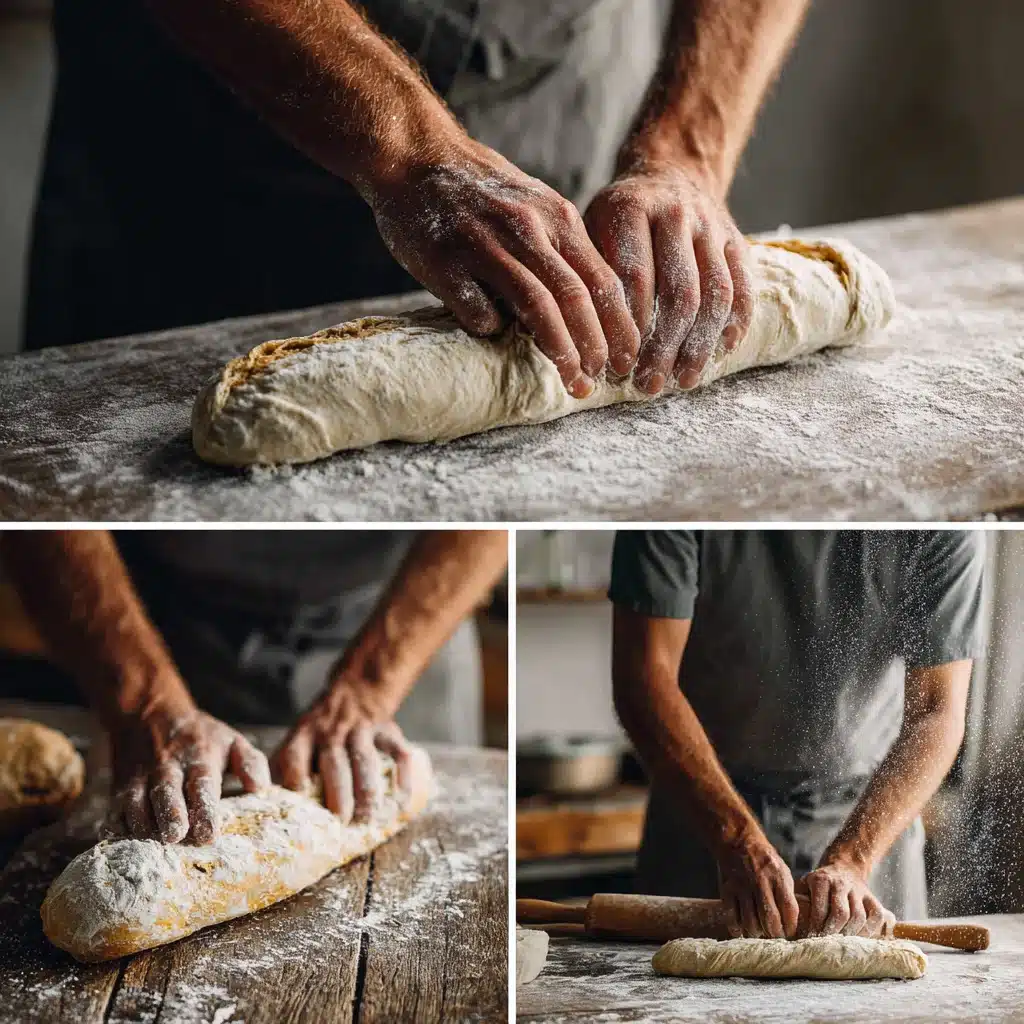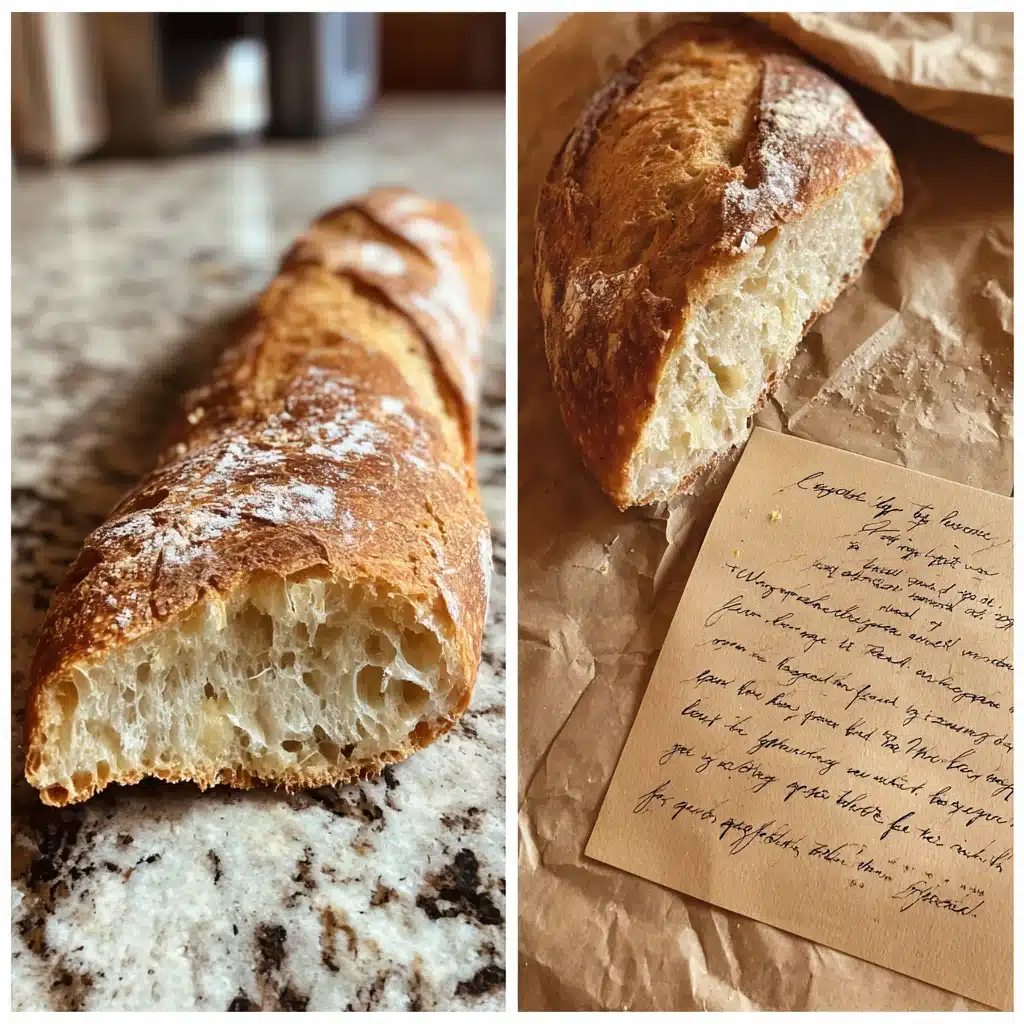There’s something timeless about baking a baguette, but when it’s made with wild fermentation, it becomes a ritual. A good sourdough baguette recipe blends crust, chew, and flavor in one long, golden loaf. It’s not just about flour and water, it’s about process, patience, and paying attention.
In this article, I’ll walk you through my complete artisan sourdough baguette recipe, developed in my Mendocino kitchen after years of sticky hands, cracked crusts, and crumb experiments. Whether you’re new to sourdough or looking to sharpen your technique, this guide covers everything from levain to the final bake.
Ready to learn how to bake sourdough baguette like a pro? Let’s get started.
The Magic Begins: My First Sourdough Baguette Recipe
I still remember the first time I tried a sourdough baguette recipe. It was a foggy Mendocino morning, and my kitchen smelled like warm flour and sea air. I had no idea what I was doing. I’d seen photos of baguettes, crusty, golden, airy, but what I pulled out of the oven that day looked more like a canoe than a loaf. Still, I was hooked.
What makes a sourdough baguette so special isn’t just the crust or shape, it’s the time and care it takes to get there. Unlike a regular yeasted loaf baguette, this one relies entirely on wild fermentation. That means no shortcuts. Just flour, water, salt, and a living culture that changes with the weather, your hands, and your rhythm.
That’s the beauty of this style. Once you understand the process, this artisan sourdough baguette recipe becomes more about feel than exact measurements. It rewards intuition and patience, not perfection.
If this is your first time working with wild fermentation, don’t worry. I’ll break it down step-by-step. We’ll build a strong levain, autolyse properly, and master bulk fermentation, all essential parts of making a baguette that sings when you slice into it.
Need a softer start? Try our sourdough bread recipe for beginners or ease into things with sourdough discard crackers. But if you’re here for that golden, crusty finish, this sourdough baguette recipe is the one you want.
Now let’s start with the first step: feeding your levain.

Crafting the Dough: Levain, Autolyse & Fermentation
Building the Levain: Where Flavor Begins
At the heart of every great sourdough baguette is the levain. This fresh, wild-fermented mix of starter, water, and flour is your loaf’s power source. To build it, combine 65 grams of active starter, 65 grams of water, and 65 grams of all-purpose flour. Let it ferment for 5 to 6 hours at room temperature, until it doubles in volume and smells slightly sweet.
Creating a levain separately from your starter gives you more control over fermentation. That’s why this step is essential in any reliable baguette recipe using sourdough. When timed right, it gives your dough strength, flavor, and rise without commercial yeast.
Use the float test, drop a spoon of levain into water. If it floats, it’s ready. If it sinks, it’s underdeveloped. Don’t rush it.
Uncertain if your starter is strong enough? Our bad sourdough starter guide shows the signs of weak fermentation so you can troubleshoot early and avoid flat loaves.
Once your levain is bubbly and active, you’re ready to move on.
The Autolyse and Dough Mixing Stage
While your levain matures, it’s time to autolyse. Mix 1000 grams of all-purpose flour (11.5% protein) with 625 grams of water in a large bowl. Stir until no dry bits remain. Then cover and rest for 30 to 45 minutes. This softens the dough and activates gluten naturally.
Autolyse is a critical technique in this sourdough baguette recipe because it makes the dough easier to handle and improves texture. It’s a quiet but powerful step that makes all the difference in the final result.
Once autolyse is complete and your levain is ripe, add 180 grams of levain, 50 grams more water, and 20 grams of salt. Mix by hand using the pinch-and-fold method. You’re not kneading, just combining gently to preserve the early structure.
Your dough should feel tacky but not wet. If it’s too dry, add a few drops more water. Too sticky? A light mist of water on your hands helps.
The hydration level here is around 70%, perfect for shaping and stretch. This balance is one reason why this homemade sourdough baguette performs well in home ovens.
You’ll recognize the texture if you’ve tried our perfect sourdough or cheese sourdough bread. But baguettes require a bit more finesse, especially in shaping.
Once the dough is mixed, cover it and let it rest for 20 minutes before bulk fermentation. This gives the salt time to dissolve and fermentation to kick off evenly.
This stage is where your dough starts to come alive. You’ll stretch and fold it during the next hour or two, allowing structure to build without overhandling. Every fold adds tension. Every rest adds rise.
By the end of this phase, you’ll have a smooth, elastic dough that’s airy yet strong, exactly what you want when making a crusty, chewy sourdough baguette that’s worthy of a bakery window.
Print
Sourdough Baguette Recipe – Ultimate Artisan Guide (11 Steps)
- Total Time: 8 hours 30 minutes
- Yield: 3 baguettes
- Diet: Vegetarian
Description
Master this artisan sourdough baguette recipe with a crispy crust and chewy crumb. Naturally leavened, flavorful, and perfect for any skill level.
Ingredients
Levain
▢ 65 grams ripe/active sourdough starter (about 1/4 cup)
▢ 65 grams water (about 1/4 cup)
▢ 65 grams all-purpose flour (about 1/2 cup)
Autolyse
▢ 1000 grams all-purpose flour, 11.5% protein (about 7.5 cups)
▢ 625 grams water (about 2 2/3 cups)
Mix Baguette Dough
▢ 180 grams ripe levain (about 3/4 cup)
▢ 50 grams water (scant 1/4 cup)
▢ 20 grams salt (about 2 tablespoons)
Instructions
1. Build the levain: Mix starter, flour, and water. Let ferment until bubbly (5–6 hrs).
2. Autolyse: Mix flour and water until combined. Let rest 45 minutes.
3. Mix: Add levain, salt, and remaining water. Mix gently.
4. Bulk ferment: Stretch and fold dough every 30 minutes for 2 hours.
5. Divide: Split into 3 equal pieces. Rest 20 minutes.
6. Shape: Form into baguettes using gentle tension.
7. Proof: Transfer to floured couche and let rise for 45–60 minutes.
8. Preheat oven to 500°F with baking steel and steam tray.
9. Score: Slash tops diagonally using a lame or razor.
10. Bake with steam 15 minutes at 500°F, then 15 minutes at 475°F.
11. Cool: Let baguettes cool completely before slicing.
Notes
Don’t skip the autolyse—it improves gluten and texture.
Use rice flour on your couche or towel to prevent sticking.
For extra crunch, leave the baguettes in the oven with the door cracked open for 5–10 minutes after baking.
- Prep Time: 8 hours
- Cook Time: 30 minutes
- Category: Bread
- Method: Baking
- Cuisine: French
Nutrition
- Serving Size: 1 slice (1/12 loaf)
- Calories: 120
- Sugar: 0.5g
- Sodium: 320mg
- Fat: 0.6g
- Saturated Fat: 0.1g
- Unsaturated Fat: 0.4g
- Trans Fat: 0g
- Carbohydrates: 25g
- Fiber: 1g
- Protein: 4g
- Cholesterol: 0mg
Keywords: sourdough baguette recipe, crusty baguette, artisan sourdough
Up next: fermentation, shaping, and baking, where the magic takes full form.

Shaping & Bulk Fermentation: The Artisan Touch
Stretch and Fold to Build Structure
Once your dough is mixed, it’s time for bulk fermentation, about 4 to 5 hours at room temperature. This period lets the dough rise while building structure through gentle stretch-and-folds.
Start 30 minutes after mixing. Lift one side of the dough, stretch it gently, then fold it over itself. Rotate the bowl and repeat this on all sides. Do this every 30 to 45 minutes for the first half of the bulk fermentation.
These folds strengthen gluten, giving your baguette its signature open crumb and chewy bite. You’ll notice the dough becoming smoother and more elastic with each round. If it feels overly slack, don’t stress, it’s a sign of higher hydration, which helps achieve that airy interior in many sourdough bread recipes.
By hour five, your dough should have expanded by at least 30%, with bubbles visible near the surface. It should feel airy but not over-proofed. If you’re aiming for a loaf with extra structure, you might appreciate methods used in my perfect sourdough bake.
Shape and Pre-Proof the Baguettes
Lightly flour your surface and turn out the dough. Divide it into 3 to 4 equal portions. Let these rest, uncovered, for 15 minutes, this helps the gluten relax and makes shaping easier.
Now shape each piece into a rough log. Roll gently into a tight baton, slightly tapering the ends. Place seam-side down on a floured couche or parchment-lined tray.
Cover the dough and let it proof again for 45–60 minutes. When ready, the baguettes should feel light and springy to the touch.
Ready to finish? In the final part of this sourdough baguette recipe, we’ll cover baking, scoring, steaming, and the secret to that beautiful golden crust.
Baking Techniques: Crust, Steam & Oven Tricks
How to Bake Sourdough Baguettes for Golden Perfection
This is the moment where dough meets heat and magic happens. To get that crisp crust and airy crumb, you’ll need three things: intense heat, proper steam, and confident scoring.
Begin by preheating your oven to 500°F (260°C) with a baking stone or steel inside. No fancy gear? Flip a heavy baking sheet upside down. On the lower rack, place a cast iron pan, this will hold water for steam.
Transfer your proofed loaves onto parchment. Score each one with a razor blade or lame, making long, angled slashes. This gives the bread a place to expand and bloom beautifully.
Slide the loaves into the oven. Quickly pour a cup of boiling water into the pan below, close the door fast, and let the steam do its work. Bake for 15 minutes, then reduce to 475°F and continue for another 10–15 minutes, rotating once for even browning.
Steam keeps the crust soft during oven spring, allowing the baguettes to rise fully. Want an even crispier finish? Turn the oven off, crack the door open, and let them sit 5 minutes longer.
Once baked, let them cool completely. The structure of the crumb finishes setting outside the oven, and cutting too early can squash the delicate interior.
Pair your creation with sourdough toast or turn leftovers into sourdough dessert.
This sourdough baguette recipe finishes with a crust that sings and a crumb that whispers of fermentation and time. Up next, I’ll tackle your most common questions about starters, scoring, and baking brilliance.

Conclusion: From Levain to Loaf
There’s something deeply fulfilling about completing a sourdough baguette recipe, from mixing the levain to hearing that crust crackle as it cools. This isn’t just bread; it’s time, care, and craft in edible form.
Whether you’re tackling your first sourdough baguette or refining your scoring technique, every loaf teaches a lesson. You’ll learn how hydration impacts the crumb, why steam is non-negotiable, and how wild fermentation builds flavor.
I’ve made every mistake possible, and each one led me to this version of the sourdough baguette recipe, a process that works, is flexible, and produces consistent results. That’s what baking should be: a balance of science and feel.
Want to experiment further? Try our croissant loaf sourdough or take your flavor game up a notch with cheese sourdough bread. They build off the same fermentation foundation used here.
This sourdough baguette is just one chapter in a bigger baking journey. Each time you shape and bake, you build intuition. So dust off the flour, prep that baking stone, and trust yourself, your next great loaf is already rising.
Sourdough Baguette FAQ: Your Top Questions Answered
What is the difference between a sourdough baguette and a regular baguette?
A sourdough baguette is naturally leavened using a wild yeast starter, whereas traditional baguettes are made with instant or active dry yeast. This slower fermentation creates deeper flavor, a more complex crust, and a chewy interior. Once you’ve tried baking a sourdough-based loaf, the difference becomes clear.
What makes a baguette truly exceptional?
Steam, fermentation, and technique. The best baguettes rely on proper dough strength and a hot, humid oven to achieve that golden crust and soft, open crumb. Scoring and shaping also play a key role. You can practice these same techniques using our sourdough bread recipe to build confidence.
What’s the biggest mistake with a sourdough starter?
Ignoring it. A sluggish or underfed starter won’t give your dough the rise it needs. Signs of a struggling culture include sour smells, no bubbles, and separation. Learn to recognize these early using our bad sourdough starter guide to keep your bakes on track.
How do I get a golden crust on my baguette?
Start with a blazing hot oven, add steam for the first 15 minutes, and score your dough with purpose. Finish the bake by leaving the oven door cracked open slightly, this dries the crust and adds extra crunch.
These tips apply whether you’re baking a baguette or another long-fermented loaf. Once you master the process, every bake becomes a little easier, and a lot more delicious.

